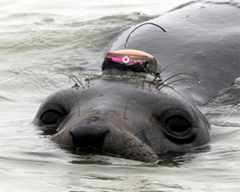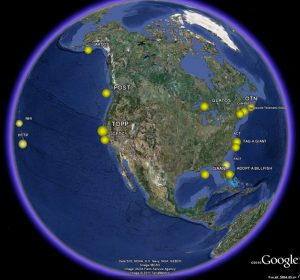Female northern elephant seal with a Wildife Computers GPS tag on her head. The tags on her lower back are archival MK 9 tags that are used to record the diving behavior (Credit: Dr. Daniel Costa, UC Santa Cruz.
Marine fisheries and living resources are vital to sustaining the Nation’s economy, employment and food security. Animal telemetry is the science of elucidating the movements and behavior of animals as they move through the world’s oceans, coastal rivers, estuaries and great lakes.
Technological advances in the last three decades have made it possible to track animals with remote-sensing devices, i.e. “biosensor or tags”. Tracking devices yield detailed data regarding the physical environment through which the animals are moving. Sometimes this can be done in near-real time – true telemetry - and in other tags the data are stored for later acquisition. Animal species that have been tagged range from 20-gram salmon smolts to 150-ton whales. Detailed observations of animal movements and their aquatic environment, have significantly improved our understanding of ecosystem function and the evolutionary constraints of species. These data are critical for preventing extinctions, preserving biodiversity and implementing EBM. Animal-Borne Sensors (ABS) have come of age and deliver high resolution physical oceanographic data at a relatively low cost.
Rapid advances in animal transmitters and data storage tags have made it possible to use animals to collect high quality biological and oceanographic observations as they cruise through ocean habitats. Sharks, tunas, salmon, sturgeon, marine mammals, reptiles and seabirds have been tagged routinely with sophisticated instruments that sample biological behaviors (diving), oceanographic variables (pressure, light, temperature, salinity), position (GPS, ARGOS, Geolocation) and biology/physiology (body temperature, heart rate, blood or tissue oxygen saturation, tail-beat, sound).
This rapidly evolving field offers unique opportunities for marine sensor technology development as scientists and engineers explore refining sensor size, accuracy, lifespan and capabilities. ABS are mobile devices that are relatively inexpensive to build and deploy (compared to ocean gliders or AUVs) and provide important insights into regions of the open oceans that are difficult and expensive to monitor. Emerging capabilities include sensors for measuring dissolved oxygen, chlorophyll, and pH. The improved miniaturization and acoustic tracking transmissions from both moored and mobile devices such as gliders or ships, has enabled ABS to relay data both locally and via satellite. The proximity tags are a sensor technology which will enable larger tagging studies. Improving transmitters that facilitate animal-to-animal communication of data would open up new horizons in understanding ecosystem connectivity.
Operationally, there is also a need for increased sharing of data via community standards and identification codes. With better data and metadata handling, a centralized repository will be possible, with the goal of placing data in near-real time onto the Global Telecommunications System (GTS).
Ocean Technology Transition Projects
For information on Ocean Technology Transition projects funded to date in support of Animal Borne Sensors, click on the link(s) below.
FY20
FY15
For more information about animal telemetry or the Animal Telemetry Network, please visit IOOS' Animal Telemetry page.
For more information about IOOS’ Ocean Technology Transition program, please contact Tiffany Vance, Program Manager.
 Official websites use .gov
A .gov website belongs to an official government organization in the United States.
Official websites use .gov
A .gov website belongs to an official government organization in the United States.
 Secure .gov websites use HTTPS
A lock or https:// means you’ve safely connected to the .gov website. Share sensitive information only on official, secure websites.
Secure .gov websites use HTTPS
A lock or https:// means you’ve safely connected to the .gov website. Share sensitive information only on official, secure websites.


